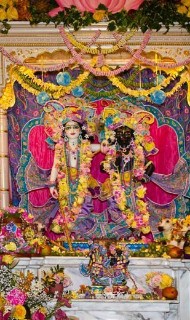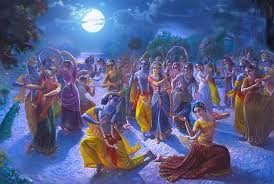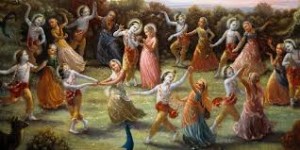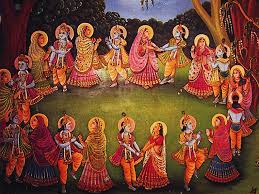Everyone assembled expressed their agreement with what the King had said. This put Pṛthu’s mind at ease, and he said, “Ah! All of you have given me a great, kind gift! You accept Hari as the ultimate goal of your efforts, the most important guide, and the supreme proprietor. And, you agree with my advice to carefully and reliably dedicate your own worldly responsibilities to his service.”
The great devotees and philosophers replied, “You are our king, of course we will follow your instructions.”
Pṛthu protested. “No. I do not give you ‘orders.’ No ruler should ever exert his power over philosophers who have fixed their consciousness upon glorifying the Supreme, and are thus enriched with a wealth of perfections such as forgiveness, forbearance, and learning.”
Note: Government and management should not extend itself to those who are self-governing and self-managing by dint of their knowledge and good qualities.
“Glorification of the Supreme” — in the opinion of Vyāsa, given in Bhāgavata and Mahābhārata, is to illuminate the supreme by focusing ones consciousness upon him via nāma-saṁkīrtan and bhāgavat-śravan.
The proof of sincere glorification of the supreme is that the glorifier becomes enriced with perfections like forgiveness, forbearance and learning.
The devotees replied, “You are empowered by Hari himself, you can certainly order us.”
Pṛthu refused, “Even Hari, the Original Person, constantly reveres and respects the feet of philosophers. This is why Goddess Lakṣmī constantly stays by his side, and this is why his fame has the power to purify the universe more powerfully than any other force.
Note: The most endearing quality of Hari is his humility. He is extremely respectful to philosophers, even though he is the most powerful ruler and authority in existence. This is the most attractive quality of Hari, and is the main thing that makes Lakṣmī fall in love with him.
It is the most purifying aspect of his fame, because it induces others to follow suit and respect the learned spiritual philosophers – and this respect for the devoted philosopher purifies society.
“He is the hidden root of every being, and is completely self-sufficient, but still he is enamored by the learned philosophers and constantly serves them by satiating their needs. Like Lakṣmī, I too greatly admire Hari’s natural humility, and want to emulate it, so I consider myself a servant of the learned, in every way.
Note: “If Hari and Lakṣmī are so enamored with philosophers and so attentive to their needs, why are they always so impoverished?”
Hari and Lakṣmī’s service to the brāhmaṇa/philosopher is not to give them things desired by those who have no philosophical depth – money, power, and so on. Rather, they serve the philosophers by “tuṣyati kāmam” – by satiating their needs, quelling their desires, removing their hunger for money and power, by giving them the desired end result (happiness) without the need for these complicated and entangling intermediaries (money, power, etc.)
“Anyone who stays in regular contact with philosophers, serving them humbly, will also soon find their own needs and desires satiated, and their consciousness filled with its own natural, peaceful satisfaction. There is no better way to perform sacrifice than to serve the philosophers.
“Do not use a fire-altar for sacrifices. Use the mouths of the philosophers. A fire has no life, what is the point of feeding it? Feed the mouths of philosophers who are experts in the subject of reality. The Limitless Supreme is far more satisfied by such sacrifice, because he is always concerned for the most civilized philosophers.
Note: This is the most practical advice! Philosophers do not have the instincts and time to earn money. Thus their families are needy, and this becomes a terrible distraction to the philosopher. Therefore everyone should give their energy to feeding the philosophers. We must supply the dedicated philosopher with adequate shelter, clothing, food, and income – then society can progress, because philosophy can flourish. A society is only as good as the quality of its morals, and without sound philosophy that quality is not at all likely to be very high. Therefore donations to the educators and students on spiritual philosophy is the primary moral duty of every non-philosopher.
Unfortunately, this has been forgotten these days, and people prefer to give their money to building buildings, theme parks, hotels, and so on. Better to take care of the family of a person who can be a dedicated philosopher/brahmana.
“Philosophers preserve the spiritual knowledge of the Veda, which is eternal, brilliant, ever-relevant. They realize this knowledge by the auspicious qualities of devotion, forbearance, silence, self-control and extreme concentration. These qualities make the philosophical mind into a mirror, upon which the true import of philosophy manifests clearly, for all to see.
“Oh honorable people,” Pṛthu concluded, “For as long as I live, I will always carry upon my crown the pollen-dust from the lotus-feet of philosophers. This will quickly destroy all my misdeeds and make me fully qualified to truly love Hari. When someone acquires such qualifications – having treasured manners, always feeling grateful, and always learning from superiors – he certainly achieves every goal conceivable, as a consequence.
“May I become satisfying to the philosophers, to the cows, and to the People’s Ultimate Refuge and his devotees.”
Note: How do cows come into this?
The cow is the greatest wealth. With cows alone, humanity can produce everything they need. So cows are the most essential animal for providing the basic necessities that philosophers and everyone require.
– Excerpt from an early draft of Part 4 of
Beautiful Tales of the All-Attractive
A translation of Śrīmad Bhāgavatam’s fourth canto
By Vraja Kishor
Parts 1, 2, and 3 of Beautiful Tales of the All Attractive
are available at VrajaKishor.com
Tagged:
Cows,
Donations,
humility 







 By Gregory
By Gregory











 By Isvara Krishna Dasa
By Isvara Krishna Dasa

 By Satyaraja Dasa
By Satyaraja Dasa By Rasa Purusha Dasa
By Rasa Purusha Dasa






